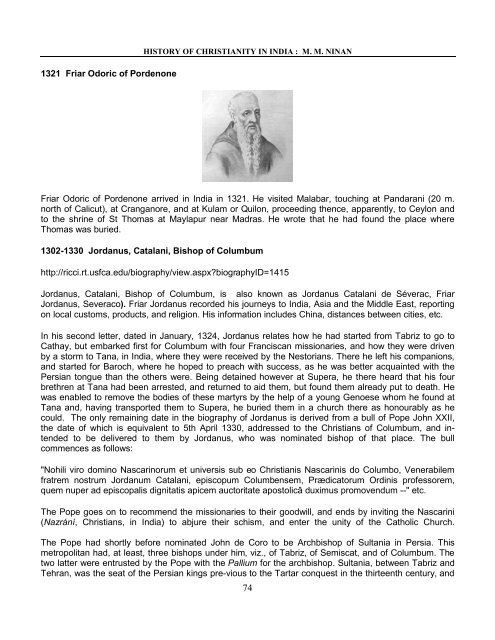Indian Christianity
Create successful ePaper yourself
Turn your PDF publications into a flip-book with our unique Google optimized e-Paper software.
1321 Friar Odoric of Pordenone<br />
HISTORY OF CHRISTIANITY IN INDIA : M. M. NINAN<br />
Friar Odoric of Pordenone arrived in India in 1321. He visited Malabar, touching at Pandarani (20 m.<br />
north of Calicut), at Cranganore, and at Kulam or Quilon, proceeding thence, apparently, to Ceylon and<br />
to the shrine of St Thomas at Maylapur near Madras. He wrote that he had found the place where<br />
Thomas was buried.<br />
1302-1330 Jordanus, Catalani, Bishop of Columbum<br />
http://ricci.rt.usfca.edu/biography/view.aspx?biographyID=1415<br />
Jordanus, Catalani, Bishop of Columbum, is also known as Jordanus Catalani de Séverac, Friar<br />
Jordanus, Severaco). Friar Jordanus recorded his journeys to India, Asia and the Middle East, reporting<br />
on local customs, products, and religion. His information includes China, distances between cities, etc.<br />
In his second letter, dated in January, 1324, Jordanus relates how he had started from Tabriz to go to<br />
Cathay, but embarked first for Columbum with four Franciscan missionaries, and how they were driven<br />
by a storm to Tana, in India, where they were received by the Nestorians. There he left his companions,<br />
and started for Baroch, where he hoped to preach with success, as he was better acquainted with the<br />
Persian tongue than the others were. Being detained however at Supera, he there heard that his four<br />
brethren at Tana had been arrested, and returned to aid them, but found them already put to death. He<br />
was enabled to remove the bodies of these martyrs by the help of a young Genoese whom he found at<br />
Tana and, having transported them to Supera, he buried them in a church there as honourably as he<br />
could. The only remaining date in the biography of Jordanus is derived from a bull of Pope John XXII,<br />
the date of which is equivalent to 5th April 1330, addressed to the Christians of Columbum, and intended<br />
to be delivered to them by Jordanus, who was nominated bishop of that place. The bull<br />
commences as follows:<br />
"Nohili viro domino Nascarinorum et universis sub eo Christianis Nascarinis do Columbo, Venerabilem<br />
fratrem nostrum Jordanum Catalani, episcopum Columbensem, Prædicatorum Ordinis professorem,<br />
quem nuper ad episcopalis dignitatis apicem auctoritate apostolicâ duximus promovendum --" etc.<br />
The Pope goes on to recommend the missionaries to their goodwill, and ends by inviting the Nascarini<br />
(Nazrání, Christians, in India) to abjure their schism, and enter the unity of the Catholic Church.<br />
The Pope had shortly before nominated John de Coro to be Archbishop of Sultania in Persia. This<br />
metropolitan had, at least, three bishops under him, viz., of Tabriz, of Semiscat, and of Columbum. The<br />
two latter were entrusted by the Pope with the Pallium for the archbishop. Sultania, between Tabriz and<br />
Tehran, was the seat of the Persian kings pre-vious to the Tartar conquest in the thirteenth century, and<br />
74


















